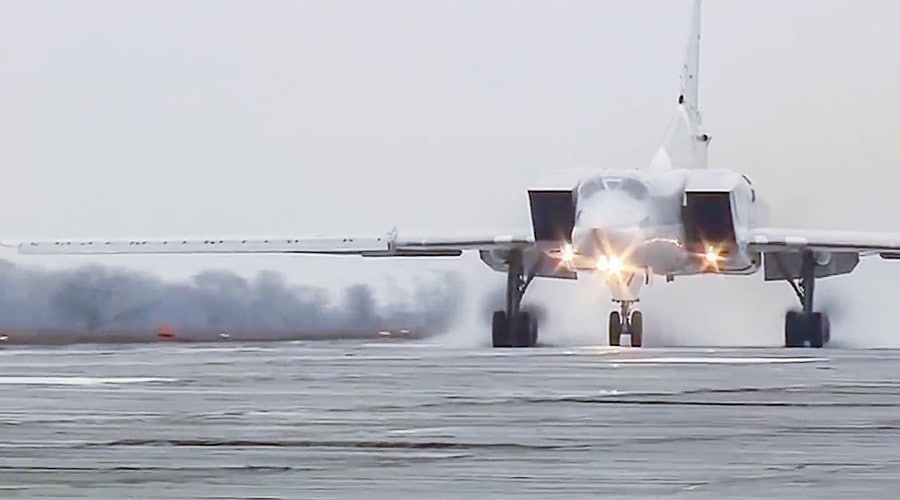The Russian Ministry of Defense today, August 16, 2016,[1] announced that Russian Tu-22M3 strategic bombers and Su-34 fighter bombers had taken off from Iran's Hamadan airbase in order to strike the Islamic State (ISIS) and Jabhat Fath Al-Sham (formerly Jabhat Al-Nusra) in Syria.[2] This is the first time Russia openly acknowledges it has deployed strategic bombers in Iran.[3]
According to Russia 24, the aim of deploying the bombers in Iran is to shorten the flight time to targets by 60%. The Russia Today channel reported, citing Russian diplomatic sources, that Russia has asked Iran and Iraq to allow Kaliber missiles to pass through their airspace. The Russia Today website added that on August 15, 2016 the Russian Defense Ministry announced the launch of tactical exercises in the Caspian Sea, involving warships bearing cruise Kaliber missiles. According to the ministry, the goal of the exercises is to test the Caspian Sea fleet's ability to respond to sudden crises, including terror-related crises.[4]
Iranian Supreme National Security Council secretary Ali Shamkhani responded to reports on Russia's use of Iran's airspace and facilities in attacks on terrorist elements in Syria, saying: "There is strategic cooperation between Tehran and Moscow regarding the war on terror in Syria, and in this field each [country] uses the abilities and facilities of the other."[5] Furthermore, the Russian daily Izvestia stated that Iran and Iraq have officially authorized Russia to use their airspace for Kaliber MK cruise missile.[6]
Semen Bagdasarov, director of the Center for the Study of the Middle East and Central Asia, said that Iran understands that the situation is difficult in northwest Syria but lacks the technical capabilities that Russia has."[7]
On August 11, 2016, Russian media also reported that Moscow plans to turn the Hmeymim base, located in Syria's northwestern Latakia province, into a fully operational base. Russian Federation Council Defense and Security Committee first deputy chairman Franz Klintsevich said: "After an agreement on its legal status, Hmeymim will become a base of Russian armed forces, all the appropriate infrastructure will be built there and our servicemen will live in decent conditions." He added that a permanent contingent of Russian Aerospace Forces (VKS) could be based at the Hmeymim airbase: "The VKS unit could be increased in accordance with bilateral agreements, but so far, from the perspective of tasks at hand, the forces currently deployed there [at Hmeymim] are enough." He also noted that nuclear weapons and heavy bombers will not be permanently deployed at the Hmeymim base in Syria as this is against international agreements.
Russian Long-Range Bombers Targeting ISIS From Iran's Hamadan Airfield - Video Released By The Russian Federation Ministry Of Defense
To view video click here or below:

A Russian Aerospace Force Tupolev Tu-22 M3 strategic bomber. (Source: Russian Federation Ministry of Defense)
Tu-22M3 Strategic Bombers: A Warning To The West
SUPPORT OUR WORK

On July 13, 2016, the Russian news agency Ria.ru published an article on strategic bombers titled "If The Enemy Does Not Surrender... Tu-22M3 Strategic Bombers Come To Visit," written by Russia Today analyst Alexander Khrolenko.[8] It stated: "On... July 12, six Tu-22M3 strategic bombers took off from Russian territory, delivered an airstrike against [ISIS] facilities... in Syria, and returned to the base airfield... The strategic bombers seemed to be acting as part of a scheduled operation of the Russian Aerospace Forces, as they had before... It is probable that the Syrian events of July 8, when ISIS militants shot down a Mi-25 helicopter with a Russian crew, had an impact on the plans of the RAF. In any case, the connection between the deaths of the pilots and the strike by the Tu-22M3 squad is chronologically quite perceptible. Still, why was the strike made not from land (by thermo-baric ammunition, for example), nor by Kalibr-NK cruise missiles from the sea, but from the stratosphere? Maybe this 'sign from above' was not intended only for the Middle East militants.
"The Tu-22M3 long-range multimode missile-carrying bomber is designed to conduct missile and bomb strikes in operational areas of land and sea theaters of war against stationary and moving objects (optically visible and radar-contrast objects, areas and points) by guided missiles and aerial bombs - as a single unit and as part of an aircraft group. The area of combat operations practically in the center of Syria evidently needed to be cleansed of large military groups and modern weapons. And TU-22M3 long-range bombers (combat radius with payload about 7000 km), capable of performing their task at any hour of the day and in any weather conditions, were very effective.
"Earlier, official representatives of the Russian Defense Ministry stated that the air base in Gvardeiskoye (Crimea) will receive in 2016 a maritime carrier-borne missile-armed regiment, including Tu-22M3 strategic bombers. It is only 980 km from the Crimean air field to Aleppo in a straight line, half an hour of flight... But these planes can do so much more.
"The Tu-22M3 long-range supersonic missile-carrying bomber (NATO reporting name: Backfire-С) is the most modern modification of Tu-22M. It carries on board powerful weapons for the destruction of ship groups in the sea and military industrial facilities deep in the enemy territory. It can conduct reconnaissance using organic on-board radio-electronic equipment, as well as actively and passively jam attacking planes, fighter-interceptor guidance and control systems, and surface-to-air missile systems.
"During the Cold War, Tu-22M3s were a constant headache for NATO headquarters in Europe, and it is no accident that these planes were called 'ship eaters.' Former confrontations were left in the past century, but it is still just one hour's flight for a Tu-22M3 from Crimea to Brussels (the Mediterranean sea is even closer), and missile weapons have become more advanced. Near Aleppo, the power of Tu-22M3 may seem excessive. Of course, Middle Eastern terrorists do not have warships. But they didn't used to have modern Western-made guided missiles either. Is it purely coincidental that a specimen of high technology weaponry (American, according to some reports) has emerged in the area of combat operations, and not for the first time?...
"Russia can greatly increase the number of mission sorties by its composite air group in Syria... and carrier aviation of the Admiral Kuznetsov cruiser (will be on combat duty in the Mediterranean from October 2016 until January 2017). And the armistice could be left in effect only for those who adhere to its terms, including western instructors of the Syrian 'opposition groups.' I think it would be fair.
"Once, Russian leaders warned our Western partners: You'd better not touch Ukraine. They did not listen. And what is the result? The Kremlin's position on the civil war in Syria was not taken into account until recently either. And it looks like our Western partners are still supplying weapons to Middle Eastern terrorists. What are they hoping for? In the German magazine Der Spiegel, Sergey Karaganov, the Russian president's advisor, plainly explains to the West: If Russia has to go to war, it will not be the way you are planning.
"The Tu-22M3 strike in Syria on July 12 may be called a tactical warning on the eve of the Russia-NATO Council meeting [that took place on July 13]. Maybe to someone in Brussels and Washington, it is a chance to realize that Russia is smarter, stronger and more determined than the West likes to think."
Endnotes:
[1] On the previous day, August 15, 2016, Mikhail Bogdanov, Russia's Special Presidential Representative for the Middle East and Africa and Deputy Foreign Minister, was received in Tehran by Iranian Foreign Minister Mohammad Javad Zarif and met with Iranian Deputy Foreign Minister for Arab and African Affairs Hossein Jaberi Ansari. The two discussed current issues in the Middle East and North Africa, including the situation in and around Syria. (Mid.ru, August 15, 2016.
[2] The Tu22-M3 (also known as Backfire) is a long-range strategic and maritime strike bomber developed by Tupolev for the Soviet Air Force. The aircraft is currently in service with the Russian Air Force and Russian Naval Aviation. The aircraft is primarily used to conduct nuclear strike and conventional attack operations. It can also be deployed in anti-ship and maritime reconnaissance missions. The aircraft is provided with hard points to carry Kh-22 stand-off missiles, Kh-15 nuclear or Kh-15P anti-radar missiles and FAB-250 or FAB-1500 free fall bombs. The wing and fuselage pylons and internal weapons bay are provided with a capacity to carry 24,000kg of weapons payload. The Tu-22M3 can fly at a maximum altitude of 14,000m and the rate of climb of the aircraft is 15m/s. The aircraft has a cruise speed of 900km/h and maximum speed of 2,300km/h. The operational range of the aircraft is 7,000km. (Source: .airforce-technology.com)
[3] Function.mil.ru, August 16, 2016.
[4] Alarabiya.net, August 16, 2016
[5] Irna.ir,
[6] Izvestia.ru, August 16, 2016.
[7] Mk.ru, August 16, 2016.
[8] Ria.ru, July 13, 2016.




